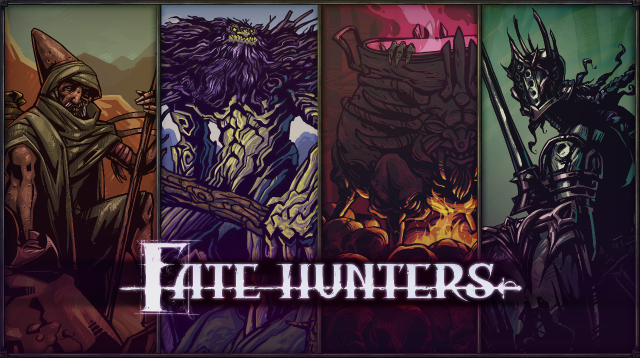Fate Hunters is a deck building dungeon crawl, and it offers a lot of choices in how you build your deck. The major problem with this is that most of those choices are uncompetitive, difficult to win with, and there’s not a lot of information on how to get to building a strong deck.
This guide isn’t about micromanaging your deck, but rather to add strategic depth. Some cards are good in just about any situation; but many of them aren’t particularly great.
Overview
Your First Ten Cards
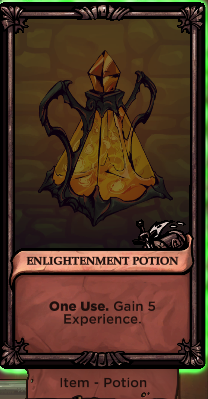 When starting Fate Hunters, you have five cards given to you based on your class.
When starting Fate Hunters, you have five cards given to you based on your class.These cards can range from absolute garbage (Punch, Healing Herbs) to a possible late game supporting cards. You can choose (and pay gold to unlock) other choices for five cards, but some of these are much better than others.
Some quick feedback on these options:
Enlightenment Potion: Always a good item, unless you’ve made it all the way to level 20, which requires a large investment in milling XP.
Torch: While Fate Hunters will not tolerate endless turtling (eventually everyone gets replaced by a Dragon, which is a boss level fight on its own), Torches work against many bosses to greatly reduce threat.
Mundane Weapons: These start a bit better than your starter items, so you may want to load up on these items. Mundane weapons are also upgradeable, which can lead to them having staying power into the end of the game.
Infernal Contract: Very risky. While I’ll talk about chaffing as its own topic in this guide, the loss of max HP is very painful – at least one encounter (Three Prowlers + Double Damage owing to treasures) deals 18 damage a round. It is not definitive you’ll be able to increase your max HP throughout a run.
When you load up Fate Hunters, you’re going to start against foes that are easily brought down by your basic weapons and skills.
Chaffing and Upgrading
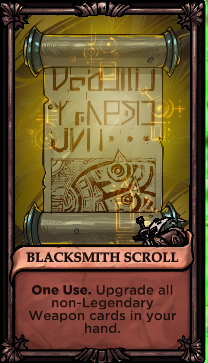 Certain Mystery Rooms allow you to encounter Blacksmiths, who are quite happy to take your treasures and upgrade your weapons. A few other cards also allow for upgrading your weapons, and they’re powerful cards in general.
Certain Mystery Rooms allow you to encounter Blacksmiths, who are quite happy to take your treasures and upgrade your weapons. A few other cards also allow for upgrading your weapons, and they’re powerful cards in general.
You can also pick up the Raider’s Hand or a few other consumable cards (Dark Potion, Plague, or the Fortune Teller’s Banishment Boons) to remove cards from your deck.
Fate Hunters isn’t very forward about what happens when you upgrade cards beyond the single next step, how far you can upgrade cards, or even if you should with your limited treasures.
There are two excellent choices to upgrade:
The Ritual Dagger looks like an underwhelming weapon, but it upgrades to +7, and deals and heals 5 hit points at this point. It is also awarded Critical Strike at this point, so it has other synergy as well. Note that the healing works even if you don’t deal any damage, so this is always somewhat useful.
The Throwing Dagger upgrades to +3, where it deals only 3 damage, but it also allows you to draw and discard three cards. Because cards with the keyword ‘enchanted’ trigger when discarded, because the Last Word Ability requires you don’t have a treasure or unplayable card in hand, and because drawing cards is very powerful, this is also an amazing card to upgrade.
Battle Axes, Long Swords, Cursed Swords generally deal a good deal of damage, and also upgrade to +3, but they lack the benefits of other choices.
Daggers are generally inferior weapons. Critical Chance can be improved via a couple of cards, which can mean doubled damage with a dagger, but deckbuilding requires reliability, and critical strikes are too shaky to build upon. One item, the dagger bandolier, will give you three daggers–which is quite the punch–but on their own, daggers aren’t particularly great cards, and upgrading them most likely means going from below average to average damage.
Rapiers, Halberds and Bows are strictly inferior weapons that you should only pick up if you are below 30 cards (Axes and Green Rings trigger on having 30+ cards). Use treasure swords to pay for these upgrades; do not upgrade them.
—
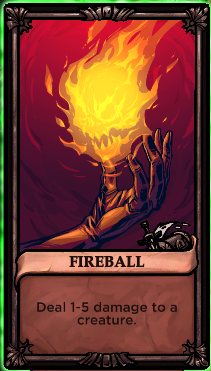 Deckbuilding also has the trait of drawing five cards; you will lose if you repeatedly get blocked by your card draws. This is built into the game (treasures are worth more the further you get), but several of the starting items/skills of the games are dead ends. Many a game has been saved because I’ve drawn a card that lets me draw more cards, and could have ended ingloriously with a big pile of damage and no options to stop it.
Deckbuilding also has the trait of drawing five cards; you will lose if you repeatedly get blocked by your card draws. This is built into the game (treasures are worth more the further you get), but several of the starting items/skills of the games are dead ends. Many a game has been saved because I’ve drawn a card that lets me draw more cards, and could have ended ingloriously with a big pile of damage and no options to stop it.
So getting rid of inferior cards also improves your deck, but how to make that decision?
The first step is the easiest one: The Toxin Card (You can only play 4 cards in a turn) is hand downs the worst card in the game, get rid of it. If you run into a spider, you will get at least one Toxin card. Wound cards have different importance in the Berserker class, but if your deck gets no use out of them they should be likewise chaffed.
Not that far ahead, Punch, Healng Herbs, and ‘random damage’ cards would follow. Fate Hunters has a lot of cards that deal ranges of damage or choose random targets. The Goblin Wand, which triggers when discarding, is generally worth holding onto, but several of the Arcanists’ spells are just too unreliable to count on.
Also roughly worth trying to cut out are magic weapons you just don’t want to use. Parasite Swords? Berserker Blades? The Elemental Staff just too unlikely to do what you need? If you can’t play them, they’re potentially worse chaff than bows and daggers.
Note that Loot Bags and Treasure Chests may have you wind up with inferior gear without you deciding to add things to your deck. You will probably need some chaffing power for the whole game. I’ve done well by purging all legendary weapons except the Crusher and Blooddrinker, and using highly upgraded throwing daggers and ritual daggers.
Bosses
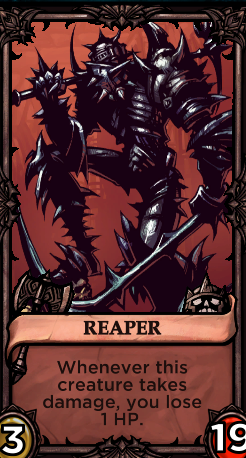 Every floor of Fate Hunter has a boss battle, which ranges from very easy to lose the game. All bosses are beatable, but some foreknowledge is very helpful.
Every floor of Fate Hunter has a boss battle, which ranges from very easy to lose the game. All bosses are beatable, but some foreknowledge is very helpful.
The Cauldron: Fate Hunter does not mention that there is a maximum number of creatures that you can fight at once (9). Using torches against The Cauldron is highly effective, and debuffing the monsters it sends can also be worthwhile.
The Hag: Has probably the most nuanced answer to having her attack dropped – she has a series of phases that will lead to her attack returning to its full value, until her final phase (Attack is 5 at this point). The Hag is also a problem in that most of her phases grant her Ethereal – so if you’re relying on weapons and not skills, you’ll wind up having to grind her down 1 HP per weapon. This isn’t impossible, but you’ll need healing and shields to trade favorably against her.
Shadow Thief Queen: Highest damage output in the game, at 9 per turn. If you have a lot of shields in your deck and can get through her HP, make no deals. But she’s scary enough that you might want to pay her off to make this fight a lot easier. If you’re not out to leave this dungeon with a lot of treasure, you may well make a deal as well. No, you do not get the treasure back after you kill her.
Mr. Mirror: The real Mr. Mirror will always have the lowest HP total, or be tied for the lowest HP Total. This is perhaps Fate Hunters’ best puzzle boss, and damage to all foes is always effective. Note that Fate Hunters restricts the field to 9 monsters and potentially fewer in this fight (I believe 6?) but if you use a ‘damage all’ card you’d wind up with 3 damage at the end of your turn.
Dragon: A straightforward 5 damage, 40 life, no Stun/Degrade Attack boss. The dragon can be stymied with shield effects. Life gain is generally always helpful, but it’s hard to gain this much life in a round.
Several Bosses are vulnerable to having their attack reduced. It is worth noting that many cards will directly note that they do not work on bosses, and if you try to play it, you will get a message “I can’t do this” instead of being able to play the card to no effect. Plan accordingly – use such cards on minions or discard them via skills/throwing daggers.
A few bosses (Skull Collector, Undead Giant, Avenger, Shadow Council) have various effects that trigger on death to extend the Boss Battle. Strongly consider leaving these bosses at 1 life if you’ve used up your hand – the next wave can hit a lot harder than the boss.
Finally, note that the big boss (Master) lets you choice the two tarot cards (not ONE) he buffs himself with. Get a shield and increase his max HP? Sure! Increase his attack? Bad idea.
The Big Choices – Choosing a Tarot Card
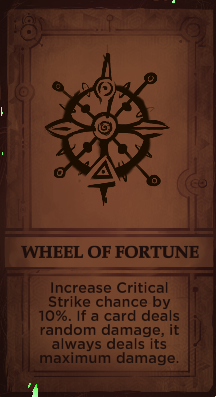 Fate Hunters has several points where you can make major changes to how your deck functions and operates. Primarily, after beating a floor, you have the chance to make some decisions at floor up. Frankly, you should ALWAYS TAKE A TAROT CARD
Fate Hunters has several points where you can make major changes to how your deck functions and operates. Primarily, after beating a floor, you have the chance to make some decisions at floor up. Frankly, you should ALWAYS TAKE A TAROT CARD
Tarot cards stack and this can be used to great effect, but options can vary in effectiveness. I’d divide the Tarot Cards into four tiers:
The Hermit: The problem with this Tarot card is that multiple big cards are a very effective deck design, and you just don’t get enough benefit for a Draw 2 card to give them up.
Lovers: Not worth losing 2 Hit Max HP. Remember, this isn’t the heroic skills, which are the very powerful cards, so this one is definitely a pass.
Temperance: Not being able to play 6 or more cards in a turn is breakingly bad. Never take this; the Tower is superior in terms of Max HP and more workable.
These cards aren’t bad, but if you don’t a specific plan to make use of them, they’re also Tarot cards to pass on.
The Fool: On Floor 4, this means getting a Tarot card early. On Floor 5, this means getting an extra Tarot card. Before this point, this Tarot card is garbage.
Judgement: This Tarot card can be a complete zero. If your deck has no self damage, this Tarot card is null. Combos powerfully with the Devil Tarot card, but you’re not going to get a lot without a build for it.
The Moon: Thieves can’t take your treasures…. This isn’t useful without cards that exile the top card of your deck. This is a flat zero without those cards.
Strength: Upping weapon damage would be great on its own, but what this does is make Ethereal foes much harder to defeat, as Skills are the primary way to deal damage to them. A pile of crushers or cards that have the Silence ability can make this advantageous, but in particular the Hag benefits heavily from dealing 1 damage instead of full damage.
The Tower: Although superior to Temperance, the Tower requires heavy use of Green Rings, the Empress Tarot Card + Treasure or effects that trigger multiple times to heal HP. Doubling Max HP is a lot, but if you don’t have a deck that can still recover HP in many different places, this isn’t a good choice. Big healing cards are basically chaff with this Tarot card.
The World: This card does very little much of the time, as you normally draw 5 cards. Directly inferior to the Magician and the Hanged Man, the World makes those Tarot cards worthless. Long Swords and a few skills reduce the number of cards you draw; conversely Rapiers and other skills increase the number of cards you draw. If your deck is making you pay repeatedly for those skills, this could start to work, but that’s a big build question.
The Devil: Interesting choice in how to deal with Curses; adding a Draw 2 to every curse card makes them generally beneficial cards. This is mutually exclusive with Hierophant–do not take both of these Tarot cards.
Death: 2 damage to everyone every time 10 weapon cards deal damage. This is up there with the Sun card as handy but rarely decisive.
The Hanged Man: Might raise this into Always Take if you can afford to banish the wound cards on Floor Up or have a berserker that benefits from wounds. Even with wounds (and you can discard and should discard them), this card is generally going to support triggering cards with Enchantment, as well as Last Word (by getting rid of unplayable cards in your hand).
The High Priestess: This card stands some chance of triggering many times, giving you an additional draw, 2HP, or both. It’s two different small benefits.
The Hierophant: The full cleanse isn’t the most powerful part of the card–it’s being able to ignore Curses outright. Curses simply get removed when they would be added, which makes the Cursed Sword potentially amazing and neuters several foes. Once again, take this or the Devil.
The Star: Adding draw a card to critical hits, and somewhat increasing their frequency is a textbook Nice to Have. Hard to see this being a top tier Tarot card, however, as there’s no guarantee when it will fire. Card draws are always helpful, though.
The Sun: Low, fairly reliable damage. Lackluster but generally supports any deck.
The Emperor: It’s +5 Hit Points, on the installment plan. What’s not to like?
The Empress: This doesn’t distinguish between treasure cards you discard and have at your hand at end of turn. So this is probably the best healing option in Fate Hunters, single handedly makes The Tower work, and perhaps best of all, makes treasure something you do want to take to the end of the game–and it helps you along the way.
The Magician: While burning 5 random cards sounds steep, the Magician is a flat extra card draw every turn, which is a steal.
Wheel of Fortune: +10% Crit chance isn’t on its own a deal maker. This card might not, strictly speaking, double the power of a random damage card, but it makes them RELIABLE. Even your treasure swords now deal 2 damage. Wheel of Fortune is even stronger in an early Arcanist run, and cards that have damage ranges are now suddenly hot commodities.
The Best Cards of the Game
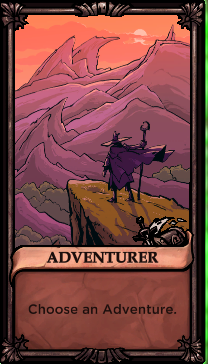 Not all cards are equal. Each class has a set of cards that include some very powerful MVP powers. These are the cards that I’ve found to be particularly powerful from each class.
Not all cards are equal. Each class has a set of cards that include some very powerful MVP powers. These are the cards that I’ve found to be particularly powerful from each class.
Inquisitor:
Preacher: Draw 3, discard 2. In a game where effects can fire on discard, this non-heroic skill allows for a lot of potential.
Shackles: -2 Attack, allows for targeting Bosses (Bosses are perhaps 50/50 on being valid targets). Another solid card for the game.
Celestial Arrows: Play this before playing a +3 Throwing Dagger to deal 18 additional damage. Or, get another card to discard your hand and one shot the master.
Arcanist:
Arcane Intellect: +3 XP, over and over again.
Tutor: Pay 1 life to set up a combo in your deck. Yeah, this one has legs…
Duplicate: Got a +7 Ritual Dagger or a +3 Throwing Knife? Have three more of them.
No More Magic: +5 Hit Points, at the cost of all non-heroic skills. This includes PUNCH, by the way. Doing this a second time is a lot harder to swallow than the first.
Runesmith: One of the best ways to get those +7 Ritual Daggers or +3 Throwing Knife.
Raider:
Curse Touch: Several hard opponents have a fairly low attack value, including Spiders, Imps and Beasts. Trade them for gold.
Nightmare: It takes time to get to 10 damage with this card; there are very few 10 damage cards in this game.
Greed: Draw 3, take 2 damage–this is the sort of card that seems like a trade off, but in practice is too one-sidedly good because of Green Rings and other cards that allow you to cycle more and more cards.
Most of the Raider’s cards require some knowledge that exiling their next card isn’t trashing a particularly good card, which can be hard to determine. The Raider benefits heavily from the Moon Tarot Card.
Berserker:
Unbreakable. Combined with the Devil or simply using wounds as a resource, this has led to one card full heals.
Frenzy: Gain +5 Rage Tokens, which is much of what you need for this class.
Tattoo: Increases your maximum rage, unlocks the Ram Card (Requires 15 Rage).
Triumphant Shout: Play this card last to gain 10 Rage without a lot of downside.
All:
Adventure: This is a pick one of three options, and this means gaining HP, drawing cards, getting a treasure chest. It rarely means fighting more enemies or taking HP Damage.
Looting: Get 2 loot bags, which is awesome.
Pot of Greed: Draw X, where X is all the treasure cards in your deck. This is absurdly powerful and should be ruthlessly exploited.
Skull Crusher: MVP legendary weapon that can summon another Skull Crusher. Come on, you can’t not pick up this card.
Final FAQ
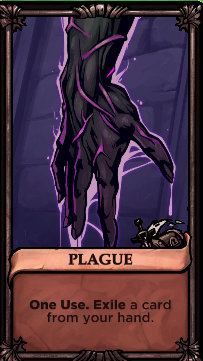 What happens if I try to target a Boss with a card that says it can not be used on bosses?
What happens if I try to target a Boss with a card that says it can not be used on bosses?
You will get a message “I can’t do this”.
Part of hand management is going to be making sure that those cards are discarded or used against monsters instead of being left alone against a boss.
Can I upgrade the treasure swords?
You can upgrade the treasure swords. Some effects, like that Blacksmith Scroll, upgrade all weapons in your hand, so this is one of the effects. An upgraded treasure sword is still an unreliable implement of destruction, so you should never pay for this and indeed may pay to upgrade a different weapon with the treasure sword.
What happens if I heal at 100% of Hit Points?
The additional healing is lost. Cards can be played to heal in this situation, and the green rings will let you draw another card, but this is not an effective use of your cards.
Should I save or use that consumable item?
This is a tricky question. Consumable items can become chaff in their own right if they keep on clogging a deck. At the same time, many items can do a lot of good at the right time and no good at the wrong time.
In general:
If you would get full HP benefit, use the healing item. Wounds are important for Berserker but I think this advice is sound. I’m always tempted to save Torches for bosses, but Freeze Potions are never going to work on them and should be used on hard encounters. If you are discovering that consumable items have gotten to 20% of your deck, consider a more relaxed attitude on using them.
Note that the Philosopher’s stone generates a consumable + 1 curse. If you have those in your deck, it may make sense to be more aggressive in using potions.
What if a card says that I have to discard, and I have nothing to discard?
You can play the card normally and ignore those costs. This is a good idea for hand management.
I have a curse or plague card, do I need to play it?
No you don’t.
Ironically, if you had both in your hand, you could use the Plague card to remove the curse card.
I clicked on banish a card, discovered I didn’t really want to banish anything and can’t take it back, am I stuck with this choice?
You are indeed. Considering banishing an unupgraded weapon or random damage skill if your obviously bad cards are out of your deck. Fate Hunters considers some choices to be binding, and you may want to check your deck before making these choices.
If you try to banish a card with Permanent, the effect ends without a card exiled. This is a waste of a card/effect but how to work around it if you’re in that position.
When do I cut my losses and leave with the gold?
Another hard to answer question, although this one has a few things in it to make an answer simpler.
If you are able to handedly defeat a floor, strongly consider moving on to the next one, as the gold multiplier increases by 50% for each floor you beat.
If you are struggling with a floor, give real thought to using a blacksmith/stranger to upgrade your deck instead of leaving. Treasure can be dead weight, and diamonds (25 GP) take up the same amount of card space as Gold Coins (10 GP).
If you know you can’t beat a floor, walk out with the money.
Finally, if you have nearly no treasure in the first place, you have little to lose by dying or trying.
What happens if I turtle to grind out XP, Healing and Weapon Upgrades?
You’ll get 1 or 2 waves of reinforcements, which aren’t particularly difficult or dangerous to deal with.
Wave 3 is a lightning round, complete with Dragon to make sure you were serious about taking your time. A Dragon is a possible Floor 2 boss and so this may be an acceptable risk to run, but a Dragon probably kills any starter deck on floor 1, and is still a hard challenge above Floor 2. Because a Dragon is both a boss and has endurance, you will not turtle against it. Nor will you get the treasure equal to a boss for beating it. Beat the first wave of reinforcements and move onto the next room if you must, but the Dragon is a bad dude.
Why do you believe small decks aren’t effective?
The Bow and Masquerade Mask would suggest there is some play for small decks, but these decks are vulnerable in a couple of different ways.
1) There isn’t enough removal to keep decks lean. The Raider has a lot of cards to exile cards, but you can very easily exile cards you want to keep, all the while the Raider is adding soul stones to try to avoid losing those cards.
2) Small decks are very vulnerable to getting choked by treasure (which you want), Toxin Cards (Which you don’t) and consumable items (which you want later). In practice, chaffing bad cards out of your deck doesn’t work out to having a smaller deck, it ends with a more efficient deck.
3) Several cards use magic number X based on the number of things in your deck. X is 20 is generally much better than X is 3, and having celestial arrows + Pot of Greed + Discard your Hand allowed me to 1 turn kill Master. You aren’t going to do this with a small deck.
You didn’t answer my question, Threeist, get back here!
That’s not a question. But I’ll poke around here once in awhile to see if I can help.

